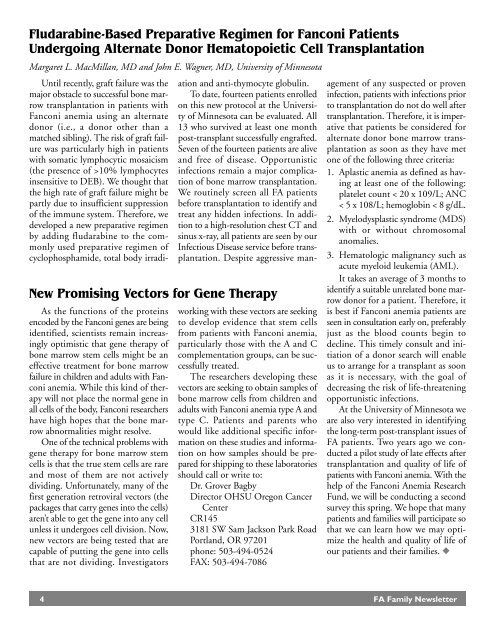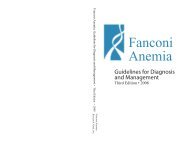FA Family News 3/01 - Fanconi Anemia Research Fund
FA Family News 3/01 - Fanconi Anemia Research Fund
FA Family News 3/01 - Fanconi Anemia Research Fund
You also want an ePaper? Increase the reach of your titles
YUMPU automatically turns print PDFs into web optimized ePapers that Google loves.
Fludarabine-Based Preparative Regimen for <strong>Fanconi</strong> Patients<br />
Undergoing Alternate Donor Hematopoietic Cell Transplantation<br />
Margaret L. MacMillan, MD and John E. Wagner, MD, University of Minnesota<br />
Until recently, graft failure was the<br />
major obstacle to successful bone marrow<br />
transplantation in patients with<br />
<strong>Fanconi</strong> anemia using an alternate<br />
donor (i.e., a donor other than a<br />
matched sibling). The risk of graft failure<br />
was particularly high in patients<br />
with somatic lymphocytic mosaicism<br />
(the presence of >10% lymphocytes<br />
insensitive to DEB). We thought that<br />
the high rate of graft failure might be<br />
partly due to insufficient suppression<br />
of the immune system. Therefore, we<br />
developed a new preparative regimen<br />
by adding fludarabine to the commonly<br />
used preparative regimen of<br />
cyclophosphamide, total body irradi-<br />
ation and anti-thymocyte globulin.<br />
To date, fourteen patients enrolled<br />
on this new protocol at the University<br />
of Minnesota can be evaluated. All<br />
13 who survived at least one month<br />
post-transplant successfully engrafted.<br />
Seven of the fourteen patients are alive<br />
and free of disease. Opportunistic<br />
infections remain a major complication<br />
of bone marrow transplantation.<br />
We routinely screen all <strong>FA</strong> patients<br />
before transplantation to identify and<br />
treat any hidden infections. In addition<br />
to a high-resolution chest CT and<br />
sinus x-ray, all patients are seen by our<br />
Infectious Disease service before transplantation.<br />
Despite aggressive man-<br />
New Promising Vectors for Gene Therapy<br />
As the functions of the proteins<br />
encoded by the <strong>Fanconi</strong> genes are being<br />
identified, scientists remain increasingly<br />
optimistic that gene therapy of<br />
bone marrow stem cells might be an<br />
effective treatment for bone marrow<br />
failure in children and adults with <strong>Fanconi</strong><br />
anemia. While this kind of therapy<br />
will not place the normal gene in<br />
all cells of the body, <strong>Fanconi</strong> researchers<br />
have high hopes that the bone marrow<br />
abnormalities might resolve.<br />
One of the technical problems with<br />
gene therapy for bone marrow stem<br />
cells is that the true stem cells are rare<br />
and most of them are not actively<br />
dividing. Unfortunately, many of the<br />
first generation retroviral vectors (the<br />
packages that carry genes into the cells)<br />
aren’t able to get the gene into any cell<br />
unless it undergoes cell division. Now,<br />
new vectors are being tested that are<br />
capable of putting the gene into cells<br />
that are not dividing. Investigators<br />
working with these vectors are seeking<br />
to develop evidence that stem cells<br />
from patients with <strong>Fanconi</strong> anemia,<br />
particularly those with the A and C<br />
complementation groups, can be successfully<br />
treated.<br />
The researchers developing these<br />
vectors are seeking to obtain samples of<br />
bone marrow cells from children and<br />
adults with <strong>Fanconi</strong> anemia type A and<br />
type C. Patients and parents who<br />
would like additional specific information<br />
on these studies and information<br />
on how samples should be prepared<br />
for shipping to these laboratories<br />
should call or write to:<br />
Dr. Grover Bagby<br />
Director OHSU Oregon Cancer<br />
Center<br />
CR145<br />
3181 SW Sam Jackson Park Road<br />
Portland, OR 972<strong>01</strong><br />
phone: 503-494-0524<br />
<strong>FA</strong>X: 503-494-7086<br />
agement of any suspected or proven<br />
infection, patients with infections prior<br />
to transplantation do not do well after<br />
transplantation. Therefore, it is imperative<br />
that patients be considered for<br />
alternate donor bone marrow transplantation<br />
as soon as they have met<br />
one of the following three criteria:<br />
1. Aplastic anemia as defined as having<br />
at least one of the following:<br />
platelet count < 20 x 109/L; ANC<br />
< 5 x 108/L; hemoglobin < 8 g/dL.<br />
2. Myelodysplastic syndrome (MDS)<br />
with or without chromosomal<br />
anomalies.<br />
3. Hematologic malignancy such as<br />
acute myeloid leukemia (AML).<br />
It takes an average of 3 months to<br />
identify a suitable unrelated bone marrow<br />
donor for a patient. Therefore, it<br />
is best if <strong>Fanconi</strong> anemia patients are<br />
seen in consultation early on, preferably<br />
just as the blood counts begin to<br />
decline. This timely consult and initiation<br />
of a donor search will enable<br />
us to arrange for a transplant as soon<br />
as it is necessary, with the goal of<br />
decreasing the risk of life-threatening<br />
opportunistic infections.<br />
At the University of Minnesota we<br />
are also very interested in identifying<br />
the long-term post-transplant issues of<br />
<strong>FA</strong> patients. Two years ago we conducted<br />
a pilot study of late effects after<br />
transplantation and quality of life of<br />
patients with <strong>Fanconi</strong> anemia. With the<br />
help of the <strong>Fanconi</strong> <strong>Anemia</strong> <strong>Research</strong><br />
<strong>Fund</strong>, we will be conducting a second<br />
survey this spring. We hope that many<br />
patients and families will participate so<br />
that we can learn how we may optimize<br />
the health and quality of life of<br />
our patients and their families. ◆<br />
4 <strong>FA</strong> <strong>Family</strong> <strong>News</strong>letter

















